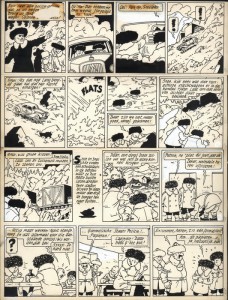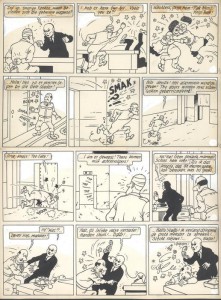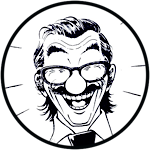UPDATE: Pierre Gay worked on these particular pages. We added his comments.
Between 1987 and 1994 Boogaloo, Casterman, Rijperman, and the Standaard Uitgeverij would re-release 8 Johan & Stefaan (Snoe & Snolleke) albums in color. As we reported already a while back, this coloring included redrawing as well as you can see in this earlier article on “De Gele Spion”, some weird Dutch phrases and words plus brand new covers.

Today we show you 2 more plates which were adapted by Bob De Moor for a release in color, again from the 1954 story “De Gele Spion”. The pages we show you today include the strips 117-120 and 125-128. As you can see on the first 4 strips the whitening Bob De Moor‘s assistent Pierre Gay applied didn’t only serve to get rid of the black shadows and decors but also to detail people in the front which he originally added in total black (see the last case of strip 118 for instance or the first case of strip 119). He also removed the original strip numbering and wrote them again on in pencil on the border of the pages.
Pierre Gay – the last artist to be hired at the Studio Hergé – worked on this particular pages and recalls: “This is a job I have done (the adaptation). All what you see in bright white used to be inked in black, to look like shadows on the black and white release. The idea was to draw over these shadows to get details for the color release of 1986 (Editor’s note: the album was released in color in 1987). The texts were masked under white parts of paper glued onto them for bilingual versions. The “dirty” marks on the texts are remains of glue.”
As we remarked already, some collectors have restored similar pages in their original form, not all that difficult since the white paint is soluble in water.

Note that the Dutch version of “De Gele Spion”, although announced for a 1988 release in color in Dutch via Casterman, was only released in French in color in 1987 via the Casterman distributed Boogaloo imprint. As a result Brabant Strip released it in 2004 in their Fenix Collection, the original black and white one in Dutch (à la Bob De Moor) that is with the black still intact. Another album, “De rode caballero” also never saw the day of light in color in Dutch, although prepared and announced by Casterman in 1989. “De zwarte draak” was announced by Casterman but in the end released 4 years later via Standaard Uitgeverij.
The list of (un)released albums in color in Dutch:
- De gele spion (Casterman – 1988) announced but never released in Dutch
- Het haatserum (Casterman – 1989)
- De sigaren van koningin Thia (Casterman – 1989)
- De schat van Baekelandt (Casterman – 1989)
- De zondebokken (Casterman – 1989)
- De rode caballero (Casterman – 1989) announced but never released in Dutch
- De zwarte draak (Casterman – 1989) announced but never released
- De zwarte draak (Standaard Uitgeverij – 1993)
- Het geheim van Vulcania (Standaard Uitgeverij – 1993)
- De schele zilvervos (Standaard Uitgeverij – 1994)
